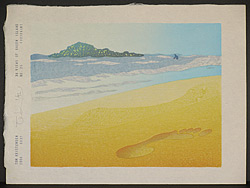Tom Kristensen Sydney Australia

|
'Footprint'
(Click image to pop-up an enlargement)
Artist's comments ...
Name: Tom Kristensen
Location: Sydney, Australia
Print Title: Footprint
Paper Dimension: 25.5 x 19 cm
Image Dimension: 20.5 x 15.5
Block: 6 blocks of custom ply. American Cherry over African Otie Ink: Waterbased ink mixed from pigment powder + gum arabic Paper: Shioji 100% kozo washi
Edition: 32 prints for BX37 + 25 prints for Green IslandComments: Human footprints are made and lost in countless numbers every day. In the sand by the water it only takes a few waves to entirely erase the signs of a person passing by. By rare chance a print is sometimes preserved and we are able to study the clues to understand something of the printmaker. Ideal conditions are needed for a print to remain as a mark in time. Fresh prints need to be quickly covered over to avoid fading to nothing.
In Italy fossilised footprints have been found dating back 350,000 years. Formed during a volcanic eruption these prints were made in the fresh pumice and then covered in the falling ash. In Australia remarkable traces of human life have been uncovered from the inland sand dunes of Lake Mungo in New South Wales. Hundreds of footprints of men, women and children tell of life as it was 20,000 years ago. This is the largest collection of fossil human footprints found anywhere in the world.
The prints were all formed in one episode by a tribe of people moving across a freshly wet clay pan. Reading the prints has combined the skills of anthropologists, archaeologists as well as the indigenous people descended from the printmakers. The native trackers who are able to read the slightest signs of life left on the landscape understand these prints as though they were made yesterday.
The prints fall into a series of tracks that show the sex and age as well as the speed, gait and weight carried by each person. Multiple tracks form into circling trackways left by people running with a shared purpose, perhaps hunting a kangaroo. A man with a group of children follows behind. A one-legged man made his track by running without trace of a crutch. This happy day, these people and their prints have now become part of the landscape.